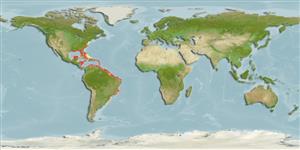>
Carangaria/misc (Various families in series Carangaria) >
Polynemidae (Threadfins)
Etymology: Polydactylus: Greek, poly = a lot of + greek, daktylos = finger (Ref. 45335).
More on author: Linnaeus.
Environment: milieu / climate zone / गहराई सीमा / distribution range
पारिस्थितिकी
समुद्री; खारा ड़िमरसल; गहराई सीमा 0 - 55 m (Ref. 26912). Tropical; 41°N - 14°S, 93°W - 35°W (Ref. 57343)
Western Atlantic: New Jersey, USA to Salvador, Brazil. Reported to range to Uruguay (Ref. 9626). Not occurring in the northern and western Gulf of Mexico.
आकार / वज़न / Age
परिपक्व अवधि: Lm ? range ? - ? cm
Max length : 33.0 cm TL पुल्लिंग / अलिंग; (Ref. 57343); common length : 20.0 cm TL पुल्लिंग / अलिंग; (Ref. 3796)
पृष्ठीय रीढ़ (सम्पूर्ण) : 8 - 9; पृष्ठीय सौफट रेज़ (सम्पूर्ण) : 11; गुदा कांटा: 3; ऐनल सौफट रेज़: 12 - 14.
Body shape (shape guide): fusiform / normal.
Found on sandy and muddy bottoms of coastal waters, estuaries and mangroves, and occasionally in the surf (Ref. 57343). Young aggregate near river mouths (Ref. 57343). Common around islands (Ref. 9710). Nocturnal feeder, taking crustaceans, chaetognaths, plant material, and polychaetes (Ref. 57343). May have a prolonged spawning season (Ref. 57343).
Life cycle and mating behavior
परिपक्व अवधि | पुनरुत्पत्ति | मछलीऔ का अंडे देना | अंडे | Fecundity | लार्वा
Motomura, H., 2004. Threadfins of the world (Family Polynemidae). An annotated and illustrated catalogue of polynemid species known to date. FAO Spec. Cat. Fish. Purp. Rome: FAO. 3:117 p. (Ref. 57343)
IUCN Red List Status (Ref. 130435: Version 2025-1)
Threat to humans
Harmless
Human uses
मात्स्यिकी: लघु वाणिज्य
साधन
Special reports
Download XML
इंटरनेट स्रोत
Estimates based on models
Preferred temperature (संदर्भ
123201): 22.9 - 28, mean 26.4 °C (based on 440 cells).
Phylogenetic diversity index (संदर्भ
82804): PD
50 = 0.5000 [Uniqueness, from 0.5 = low to 2.0 = high].
Bayesian length-weight: a=0.00661 (0.00541 - 0.00806), b=3.11 (3.06 - 3.16), in cm total length, based on LWR estimates for this species (Ref.
93245).
Trophic level (संदर्भ
69278): 3.7 ±0.4 se; based on diet studies.
लौटाव (संदर्भ
120179): ऊंचा, न्यूनतम जनसंख्या दुगनी समय अवलागत 15 महीने। (Preliminary K or Fecundity.).
Fishing Vulnerability (Ref.
59153): Low vulnerability (23 of 100).
🛈
Nutrients (Ref.
124155): Calcium = 176 [88, 325] mg/100g; Iron = 1.17 [0.60, 2.03] mg/100g; Protein = 19.5 [18.0, 21.1] %; Omega3 = 0.272 [0.172, 0.423] g/100g; Selenium = 51.1 [27.2, 99.4] μg/100g; VitaminA = 16.1 [7.3, 34.6] μg/100g; Zinc = 1.37 [0.95, 1.99] mg/100g (wet weight);
